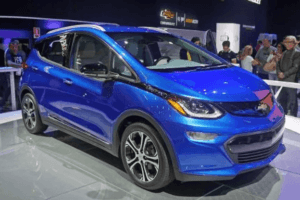2017 Will Be Remembered as the Year Electric Cars Came of Age
Many automakers are on Tesla’s tailpipe. (Photo: JOHANNES EISELE/AFP/Getty Images)
A wave of affordable, reliable and attractive 2017-model-year electric cars with impressive range is now hitting the market
Electric cars were once only for wealthy Silicon Valley techno-geeks, tree-hugging environmentalists and Ed Begley Jr.?
That stereotype is soooo 2015.
America of 2017, say hello to the affordable and eminently attractive gas-free electric. A wave of affordable, reliable and attractive 2017-model-year electric cars with impressive range is now hitting the market. Plug-in hybrids and full electrics, approaching and exceeding the magic 200-mile range threshold and priced at about $30,000, are approaching the sweet spot for broad commercial acceptability.
It’s a sad and unpleasant fact for green-leaning auto enthusiasts that plug-in electric vehicles—that is to say, any electric that’s not a self-charging gas hybrid like the popular Toyota Prius—have been stalled at roughly 100,000 annual sales in America since 2013, representing a paltry 1.5 percent of the domestic auto market. The reason? Most manufacturers have yet to figure out how to produce cars with large, high-performance batteries at a decent price that offer adequate range without recharging. Most automakers do have electric and hybrid models now, but they are derisively labeled “compliance cars” to meet California’s zero-emissions vehicle quotas. They have crummy range, high sticker prices and pedestrian amenities.
But already, there are at least 34 all-electric or plug-in hybrids on the American market, up from 22 in early 2015. And the real news: The improvement in quality and price point.
Headline-grabbing Tesla leads the pack with its flashy and high-performing Model S. The company’s signature vehicle features a range of about 270 miles, but with a $70,000 price tag, it’s still out of reach for most consumers.

Chevrolet Bolt. Wikimedia.
What’s really got electric vehicle (EV) enthusiasts excited is the viability of mass-market cars like the Chevrolet Bolt. Recently named Motor Trendmagazine’s 2017 car of the year, the Bolt is Detroit’s first serious EV: It boasts a pace-setting 238 miles of range—more than triple some of its competitors and beyond what most drivers need without a charge. The car retails at $37,495, which drops below $30,000 with the $7,500 federal tax credit. Writes Motor Trend, “there are no caveats, no ‘for an electric car’ qualifiers needed in any discussion. It is, simply, a world-class small car.”
Other automakers are hot on Chevy’s bumper. The 2017 BMW 330e (starting at $44,695) has convinced many that Tesla no longer wears the luxury model EV crown. Toyota, Kia, Chrysler and Volkswagen models now have good range, mileage and affordability for sedans and minivans, rounding out the class of EVs for the full range of buyers. Tesla’s much awaited, soon-to-launch Model 3 will retail at $35,000before tax breaks.
The other side of the range equation is the rapid nationwide proliferation of charging stations. Even with EV range comparable to gas-powered cars, without charging stations when you drive afield, you’re up a creek. But the charging network is hitting critical mass, and geolocators like Plugshare make finding a charge easy from anywhere. More than 2,000 are fast-charge or “superchargers” that can fully charge a car in as little as 40 minutes. Northern California just launched a plan for 7,500 EV charging stations. In New York State, there were more than 600 charging stations as of last January (serving 13,000 EVs), and in New York City, Tesla charging stations alone now far outnumber gas stations.
Lastly, EVs are growing at the same time as a triad of electricity grid innovations: residential solar power, home batteries and variable time-of-use electricity pricing. PV solar panels are now on 1 million American household rooftops, and the price and financing options for home solar keep getting more attractive. Homes and businesses are also adopting ever-cheaper and better energy-storage devices, such as Tesla’s PowerWall and electric vehicle batteries, giving the public options for when and how to use electricity. Now that customers have more flexibility with their consumption, utilities are starting to charge them more at peak times of the day when electricity is most expensive to produce, such as midday in the hot summer, and the early evening when every home is using its appliances and devices.
The convergence of these trends leads to this: Your rooftop solar panel charges your parked, plugged-in EV during the sunny daytime hours. Then you draw down those sun-powered electrons off your EV’s battery for your household power needs (or to send them to the grid for cash) during peak evening hours when grid electricity is expensive and often powered by coal plants. Voilà! Consumers use their EVs to minimize electricity bills and reduce emissions. This will likely become the standard in electricity markets nationwide to scale up renewable energy deployment, improve grid performance and make power cheaper.
In short, electric vehicles are now no longer a punch line. They’re just good cars that can also power your house.
View the original article here
About Manganese X Energy
Manganese’s X mission is to acquire and advance high potential manganese mining prospects located in North America with the intent of supplying value added materials to the lithium ion battery and other alternative energy industries. In addition our company is striving to achieve new methodologies emanating from environmentally and geographically ethical and friendly green/zero emissions technologies, while processing manganese at a lower competitive cost.
For more information, visit the website at www.manganesexenergycorp.com.
ON BEHALF OF THE BOARD OF DIRECTORS
Martin Kepman
CEO and Director
martin@kepman.com
1-514-802-1814
Cautionary Note Regarding Forward-Looking Statements:
Neither TSX Venture Exchange nor its Regulation Services Provider (as that term is defined in the policies of the TSX Venture Exchange) accepts responsibility for the adequacy or accuracy of this release.
This news release contains „forward-looking information“ including statements with respect to the future exploration performance of the Company. This forward-looking information involves known and unknown risks, uncertainties and other factors which may cause the actual results, performance or achievements of the Company to be materially different from any future results, performance or achievements of the Company, expressed or implied by such forward-looking statements. These risks, as well as others, are disclosed within the Company’s filing on SEDAR, which investors are encouraged to review prior to any transaction involving the securities of the Company. Forward-looking information contained herein is provided as of the date of this news release and the Company disclaims any obligation, other than as required by law, to update any forward-looking information for any reason. There can be no assurance that forward-looking information will prove to be accurate and the reader is cautioned not to place undue reliance on such forward-looking information. We seek safe harbor.

